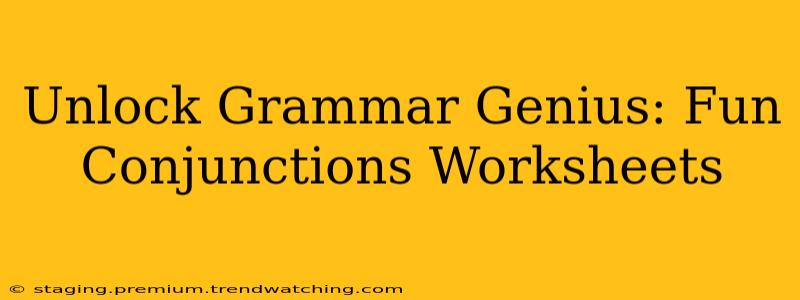Conjunctions! Those little words that connect our thoughts and ideas, making our sentences flow smoothly and elegantly. But for many students, understanding and using conjunctions correctly can feel like navigating a grammar maze. This post is designed to help you unlock your inner grammar genius with engaging conjunctions worksheets that make learning fun and effective. We'll explore different types of conjunctions and offer ideas for creating exciting worksheets that cater to various learning styles.
What are Conjunctions?
Before we dive into the fun, let's quickly recap what conjunctions are. Conjunctions are words that join words, phrases, or clauses. They act as bridges, connecting different parts of a sentence to create a cohesive whole. There are three main types:
-
Coordinating Conjunctions: These connect words, phrases, or clauses of equal grammatical rank. Think of the acronym FANBOYS: For, And, Nor, But, Or, Yet, So.
-
Subordinating Conjunctions: These introduce dependent clauses, which cannot stand alone as complete sentences. Examples include because, although, since, if, while, unless, after, before, until.
-
Correlative Conjunctions: These work in pairs to connect words, phrases, or clauses. Examples include both…and, either…or, neither…nor, not only…but also.
Fun Conjunctions Worksheet Ideas:
Now for the exciting part – turning the learning of conjunctions into a fun and engaging activity! Here are some ideas for creating your own worksheets:
1. Fill in the Blanks:
This classic worksheet type is highly adaptable. Provide sentences with blanks where students need to choose the appropriate conjunction from a word bank. Vary the difficulty by including sentences with different grammatical structures and requiring different types of conjunctions.
Example: The dog barked loudly, ______ the cat hissed back. (Word Bank: and, but, or, so)
2. Sentence Combining:
Give students short, simple sentences and challenge them to combine them using appropriate conjunctions. This helps them understand the function of conjunctions in creating more complex and meaningful sentences.
Example: The sun was shining. We went to the park. (Combine using a suitable conjunction)
3. Picture Prompts:
Use pictures to inspire sentence creation. Show a picture depicting two related events or actions and ask students to write a sentence using a conjunction to connect the events. This can be particularly effective for younger learners.
4. Story Starters:
Provide engaging story starters that require the use of conjunctions to develop the narrative. This encourages creative writing while reinforcing the use of conjunctions.
Example: It was a dark and stormy night, ______ I couldn't sleep.
5. Conjunction Bingo:
Create Bingo cards with different conjunctions. Call out sentences, and students mark the appropriate conjunction on their cards if it's used in the sentence. The first to get Bingo wins!
6. Conjunction Puzzles:
Create crossword puzzles or jigsaw puzzles where clues involve using specific conjunctions correctly in a sentence. This adds a fun, interactive element to the learning process.
7. Conjunction Sort:
Provide a list of conjunctions and ask students to categorize them according to their type (coordinating, subordinating, correlative). This helps students understand the different roles of various conjunctions.
Frequently Asked Questions (FAQs):
What are some common mistakes students make with conjunctions?
Common mistakes include using the wrong conjunction for the context, using comma splices (joining two independent clauses with only a comma), and failing to understand the difference between coordinating and subordinating conjunctions.
How can I make conjunctions worksheets more engaging for different learning styles?
Use a variety of methods, including visuals, games, puzzles, and collaborative activities, to cater to visual, kinesthetic, and auditory learners.
What are some resources available for creating conjunctions worksheets?
Numerous websites and educational resources offer printable worksheets and templates for creating your own. You can also use word processing software or online tools to design customized worksheets.
How can I assess student understanding of conjunctions?
Use a combination of formative and summative assessment methods, such as observation, class discussions, quizzes, and more complex writing assignments that require the correct use of conjunctions.
By using these fun and creative worksheet ideas, you can transform the often-dreaded task of learning conjunctions into an engaging and rewarding experience for your students. Remember to adjust the difficulty level to suit your students’ abilities and always provide positive reinforcement and feedback. Unlocking grammar genius is a journey, not a race!

